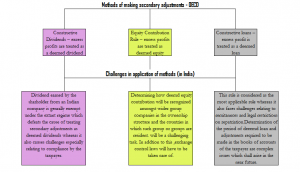Introduction
The concept of Secondary Adjustments is introduced in the arena of Transfer Pricing laws by Finance bill 2017 (hereinafter referred as the Bill). A new section 92CE is inserted in the Income Tax Act,1961(hereinafter referred as the Act), giving statutory validity to this concept. The Act encompasses two types of adjustments in case of transfer pricing namely primary adjustment and secondary adjustment. “Primary adjustment” to a transfer price means the determination of transfer price in accordance with the arm’s length principle resulting in an increase in the total income or reduction in the loss, as the case may be, of the assessee. The Act lays down that a Secondary adjustment can be carried out in certain cases where a Primary Adjustment to transfer price, —
| (i) | has been made suo motu by the assessee in his return of income; |
| (ii) | made by the Assessing Officer has been accepted by the assessee; |
| (iii) | is determined by an advance pricing agreement entered into by the assessee under section 92CC; |
| (iv) | is made as per the safe harbour rules framed under section 92CB; or |
| (v) | is arising as a result of resolution of an assessment by way of the mutual agreement procedure under an agreement entered into under section 90 or section 90A for avoidance of double taxation, |
Secondary Adjustments
According to Section 92CE of the Act “Secondary Adjustment” means an adjustment in the books of accounts of the assessee and its associated enterprise to reflect that the actual allocation of profits between the assessee and its associated enterprise are consistent with the transfer price determined as a result of primary adjustment, thereby removing the imbalance between cash account and actual profit of the assessee. In order to align the transfer pricing provisions in line with OECD transfer pricing guidelines and international best practices, this new section (92CE) is introduced in the extant tax regime.
The need for secondary adjustments was first recognised in the case of PMP Auto Components Pvt Ltd [TS-263-ITAT-2014(MUM)-TP]. In this case the revenue authorities made secondary adjustment on account of interest chargeable on loan transaction with Associated Enterprise (AE) as the taxpayer had not realized any amount of interest from additional capital investment made into its AE. The Income Tax Appellate Tribunal ruled in the favour of the taxpayer holding that secondary adjustment is not permissible as per the then existing TP provisions. This triggered the government to introduce the new amendment relating to secondary adjustments
Analysis of Section 92CE
| Sr No | Provisions | Analysis |
| 1. |
Section 92CE (1) It states that secondary adjustments can be made only in case of specified primary adjustments. |
It entails that only in cases wherein a primary adjustment falls within the purview of instances laid down under 92CE. When primary adjustment
|
| 2. | Inapplicability of Section 92CE (1) in certain cases | Section 92CE (1) shall not apply in the following cases
|
| 3 | Section 92CE (2) |
|
| 4. | Section 92CE (3) | Definitions
|
A Company ABC, is a captive service provider providing services to its holding company, Company PQR. The services are provided on a cost plus basis at the actual transaction price of cost of $1000 + 10% markup = $1100. However computed arm’s length price comes out to be Cost of 1000 + 15% markup = $1150.
In this case
-
a) Primary adjustment
Primary adjustment in the hands of Company ABC: $1150 – $1100 = $50 ( arms length price – actual price) on which tax will be paid. But it may be seen that the excess cash in the hands of Company PQR is $50. However, there is no adjustment in the hands of PQR or ABC for the excess cash in hands of PQR and cash deficit in the hands of ABC to the extent of $50.
(b) Secondary Adjustment
Secondary Adjustment seeks to address the following
- the impact of the excess cash of $50 in the hands of Company PQR
- the impact of cash deficit of $50 in the hands of Company ABC.
Had the transaction been conducted at arm’s length originally, the amount of $50 would have been reported in the books of accounts of Company ABC, and collected in the ordinary course of business. Eventually, Company ABC would incur cost related to repatriation of the amount of 50.
Therefore, to address the above issue it is proposed to provide that where as a result of primary adjustment to the transfer price, there is an increase in the total income or reduction in the loss, as the case may be, of the assessee, the excess money which is available with its associated enterprise, if not repatriated to India within the time as may be prescribed, shall be deemed to be an advance made by the assesse to such associated enterprise and the interest on such advance, shall be computed as the income of the assessee , in the manner as may be prescribed.
In the above example, as per the Bill , Secondary Adjustment is proposed to operate in the following manner:
– Every company with a Primary Adjustment must capture such amount ($50) in its books of accounts, and also the books of accounts of the related party
– The amount so booked ($50) must be received within a stipulated period, else interest would be applied at a rate specified under Rule 10CB of Income Tax Rules 1962.
In other words, if the amount of primary adjustment is not received into the country, such balance would be treated as an advance on which interest would be applied in a manner, yet to be prescribed.
Under the secondary adjustment provision, if the primary adjustment is not repatriated to India within a prescribed time, the amount not repatriated would be deemed to be an advance made by the taxpayer to such AE and interest would be charged on the advance in the manner prescribed.
CBDT Notified Rule 10CB for Secondary Adjustments under Section 92CE of the Act on 15th June, 2017 which prescribes the time limit of repatriation and the rate of calculation of interest.
Time limit prescribed for repatriation is on or before 90 days: –
- from the due date of filing of return under sub-section (1) of section 139 of the Act where primary adjustments to transfer price has been made suo-moto by the assessee in his return of income;
- from the date of the order of Assessing Officer or the appellate authority, as the case may be, if the primary adjustments to transfer price as determined in the aforesaid order has been accepted by the assessee;
- from the due date of filing of return under sub-section (1) of section 139 of the Act in the case of agreement for advance pricing entered into by the assessee under section 92CD;
- from the due date of filing of return under sub-section (1) section 139 of the Act in the case of option exercised by the assessee as per the safe harbour rules under section 92CB; or
- from the due date of filing of return under sub-section (1) section 139 of the Act in the case of an agreement made under the mutual agreement procedure under a Double Taxation Avoidance Agreement entered into under section 90 or 90A
While generally providing a 90-day time limit for repatriation, the rules require charging an annual interest beyond the prescribed period until the advance is settled
The imputed per annum interest income on excess money which is not repatriated within the time limit as per the above provisions shall be computed; –
- at the one year marginal cost of fund lending rate of State Bank of India as on 1st of April of the relevant previous year plus three hundred twenty five basis points in the cases where the international transaction is denominated in Indian rupee; or
- at six month London Interbank Offered Rate as on 30th September of the relevant previous year plus three hundred basis points in the cases where the international transaction is denominated in foreign currency.
The OECD Transfer Pricing Guidelines for Multinational Corporations and Tax Administrations (“OECD transfer pricing guidelines”) define the term secondary adjustments as “an adjustment that arises from imposing tax on a secondary transaction”. A secondary transaction is further defined as “a constructive transaction that some countries will assert under their domestic legislation after having proposed a primary adjustment in order to make the actual allocation of profits consistent with the primary adjustment.” The provisions of secondary adjustment are internationally recognised and are already part of the transfer pricing rules of many leading economies in the world. Whilst the approaches to secondary adjustments by individual countries vary, they represent an internationally recognised method to align the economic benefit of the transaction with the arm’s length position.
As per the OECD’s Transfer Pricing Guidelines for Multinational Enterprises and Tax Administrations (“OECD transfer pricing guidelines”), secondary adjustment may take the form of constructive dividends, constructive equity contributions (Equity Contribution Rule), or constructive loans.
India has adopted the constructive loan approach which is the most suitable method keeping in mind the Indian tax regime. It was quite impossible for India to adopt the constructive Dividend or Constructive Equity Contribution Rule as each method poses a different set of challenges as discussed above.
Conclusion
The government is leaving no stone unturned to curb tax evasion and base erosion in India. The introduction of secondary adjustments is a step towards adopting a globally accepted practice which provides a 360-degree impact to the concept of Arm’s length price. A bundle of compliance requirements and increasing litigation is surely in store for the tax payers and tax authorities.




